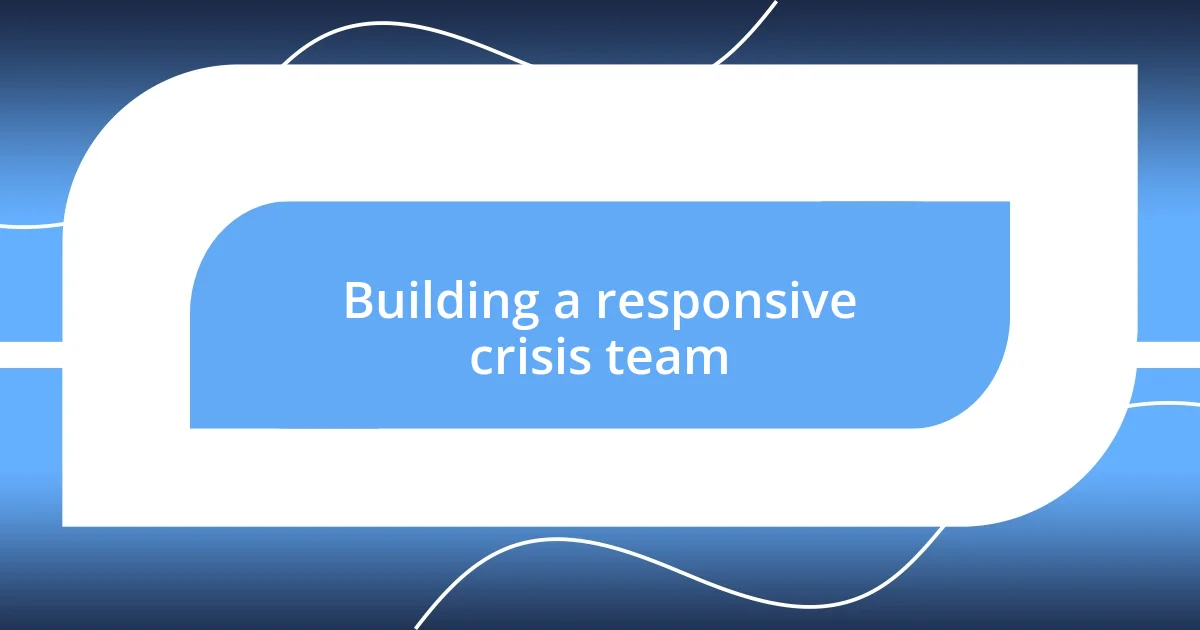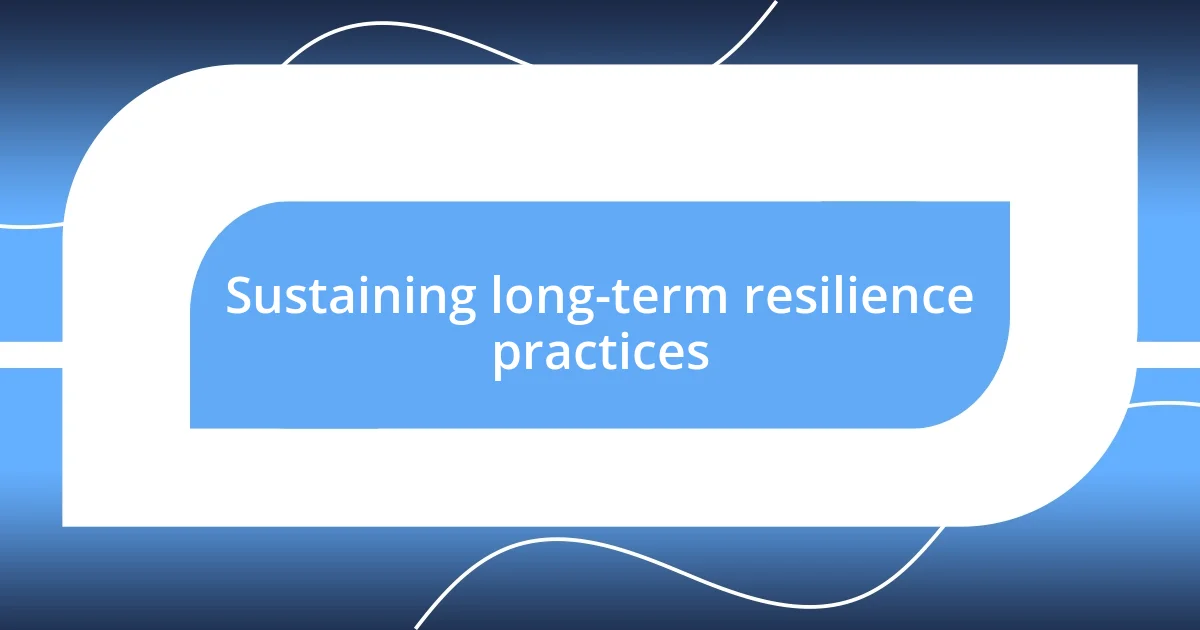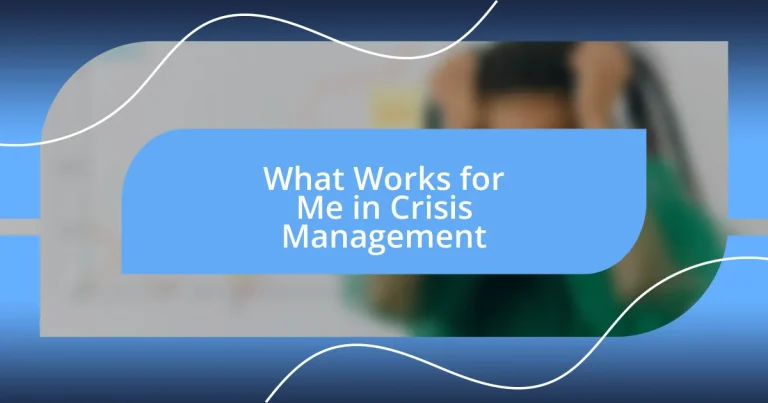Key takeaways:
- Proactive crisis management involves thorough preparation and continuous communication to build trust and resilience before and during a crisis.
- Building a diverse and responsive crisis team is essential, emphasizing open communication, defined roles, and emotional support to navigate challenges effectively.
- Post-crisis evaluation and structured learning are crucial for growth, allowing teams to reflect on experiences and improve future crisis response strategies.

Understanding crisis management principles
Crisis management principles revolve around preparation, communication, and resilience. From my experience, the key is having a well-thought-out plan before a crisis strikes. I remember a time when our team had to navigate through a sudden public relations issue. It was daunting, yet we quickly realized that clarity and prompt communication with our stakeholders were vital in restoring trust.
At its core, effective crisis management hinges on understanding the dynamics of the situation at hand. I often ask myself, “What is the real impact of this crisis on our organization and our people?” This question guides my approach to developing strategies that are not just reactive but proactive in nature, focusing on long-term recovery rather than just immediate fixes.
Moreover, resilience is an often-overlooked principle in crisis management. A robust crisis response isn’t just about managing the present; it’s about building a foundation for the future. During a challenging work period, our team learned to adapt quickly, and honestly, this experience reinforced the strength we had as a unit. Have you ever been faced with a tough situation that ultimately led to your growth? Those moments teach us invaluable lessons about flexibility and determination.

Identifying potential crises beforehand
Identifying potential crises before they erupt is essential for any organization. I recall a project where we conducted a thorough risk assessment. We listed various factors that could derail our efforts, ranging from supply chain disruptions to unexpected regulatory changes. This proactive approach opened my eyes to numerous vulnerabilities I didn’t initially consider.
In my experience, it’s not just about identifying obvious threats—sometimes, the less apparent ones can be equally damaging. For instance, we once underestimated the impact of poor employee morale during a leadership transition. We learned that monitoring internal sentiments was just as crucial as keeping an eye on external market trends. Understanding that crises can come from unexpected places has helped me refine our assessment processes.
A well-defined crisis identification strategy should incorporate data analysis and team insights. I remember collaborating with my colleagues to create a crisis matrix that outlined potential scenarios and their possible effects on our operations. This exercise was eye-opening. It not only helped us prepare better but also fostered a culture of openness where team members felt comfortable voicing concerns. This collaborative process brought us closer and made us all feel more invested in our crisis management plan.
| Type of Crisis | Indicators |
|---|---|
| Operational | Supply chain disruptions, resource shortages |
| Reputational | Negative social media trends, public complaints |

Building a responsive crisis team
Building a responsive crisis team is a critical aspect of effective crisis management. I recall establishing a small team specifically tasked with crisis response during a particularly challenging project. The energy in the room was palpable as we discussed the skills each member could bring to the table. I felt a sense of empowerment knowing that we were collectively committed to navigating any storm together.
Creating a crisis response team involves careful consideration of diverse skill sets. Here are some key elements to keep in mind:
- Diverse Representation: Ensure team members from various departments are included to bring different perspectives.
- Defined Roles: Clearly outline responsibilities so everyone knows their part in a crisis.
- Open Communication: Foster an environment where team members can share ideas and concerns freely.
- Regular Training: Conduct mock drills to keep the team sharp and responsive.
- Emotional Support: Build a culture of empathy, allowing for discussions about feelings and stresses that arise during crises.
I also remember a moment during one crisis when a team member stepped up to lead a discussion. The bond formed in those intense moments deepened our trust in one another. Reflecting on that experience, I realized that the emotional strength of a team is just as valuable as their technical skills. A responsive crisis team is not just about processes; it’s about people working together to rise above adversity.

Developing effective communication strategies
Effective communication strategies are the backbone of successful crisis management. I’ve learned that clarity is paramount. During a recent incident where a product recall was necessary, I vividly recall drafting messages that explained the situation in straightforward language, focusing on what was being done to resolve the issue. It felt rewarding when customers expressed appreciation for being kept informed, reinforcing my belief that transparency fosters trust.
In my experience, listening is just as important as delivering messages. I remember setting up a feedback loop post-crisis where team members could voice their thoughts and concerns. This process revealed insights that I hadn’t considered, like how different departments perceived our communication. Hearing their perspectives not only enhanced our strategy but also made everyone feel valued, showing me that communication isn’t only about speaking—it’s also about creating a dialogue.
Building a culture of accessibility is another key element I’ve found essential. Early on in my career, I initiated “open office hours” where team members could drop in to discuss any concerns. It amazed me how many issues unraveled simply because we created a space for conversations. This approach not only empowered employees to share their thoughts without hesitation but also bridged gaps that could widen during a crisis. Have you ever felt more confident tackling a problem after voicing it out loud? That’s the power of open communication.

Implementing crisis response plans
Implementing a crisis response plan starts with thorough training. I once coordinated a comprehensive workshop that simulated a potential crisis, allowing team members to practice their roles in real-time. The tension in the room was palpable, yet there was also a sense of excitement—each drill revealed strengths and areas for improvement, reinforcing the importance of preparation. Have you ever found unexpected confidence in the face of a challenge?
The next step is to ensure that everyone knows the plan inside and out. I remember when we faced a minor operational hiccup and realized that not all team members were fully briefed on the procedures. The confusion it caused reminded me that integration and repetition are key to a successful implementation. When everyone is aligned, it creates a seamless response that can significantly mitigate the impact of a crisis.
Finally, evaluating the effectiveness of the crisis response plan post-incident is crucial. After one particularly chaotic day, I gathered the team to reflect on what went well and what could be improved. The insights shared during that debrief were invaluable—some team members felt empowered by their decisions, while others felt overwhelmed, highlighting the importance of adaptability in our approach. This moment drove home the idea that each crisis is a lesson learned, and adapting our plans is just as important as having them in the first place. How do you ensure your team grows from these experiences? It’s all about turning challenges into opportunities for learning and connection.

Evaluating and learning from crises
I’ve learned that evaluating a crisis is not just about looking back; it’s about digging deep into what truly happened. I remember one incident where I thought we had navigated a public relations issue fairly well, but a follow-up survey revealed that many stakeholders felt we didn’t address their concerns adequately. It hit me hard; realizing that our perception differed from theirs was a wake-up call. How often do we assume we’ve done a great job, only to find out we missed the mark?
After each crisis, I make it a point to encourage open discussions and honest feedback. During one debriefing session, a junior team member bravely shared how they felt sidelined during decision-making. Their perspective opened my eyes to a significant oversight and made me appreciate the diversity of thought in our team dynamics. Have you ever noticed how fresh eyes can reveal hidden flaws in our processes? This experience taught me that the best evaluations come from collective reflection, not just a top-down analysis.
Lastly, I’ve come to value a structured approach to learning from crises in a documented manner. After one particularly tough experience, I established a “Lessons Learned” document within our team. It wasn’t just about what went wrong; it was a repository of insights, emotions, and strategies for future reference. Reflecting on that together not only refined our strategy but also united the team, reminding us that resilience often springs from understanding our shared experiences. Isn’t it empowering to transform setbacks into stepping stones for future success?

Sustaining long-term resilience practices
Sustaining long-term resilience practices requires continual self-care and mindfulness, which I’ve personally found invaluable. There was a time when I burned out after back-to-back crises, neglecting my own well-being as I prioritized the team’s needs. It was a tough lesson learned—how can you support others if you’re running on empty? Since then, I’ve integrated daily practices like meditation and regular check-ins with myself, which help me maintain a clear mind and steady focus during turbulent times.
Another key aspect is fostering a culture of adaptability within the team. I recall a project where unexpected changes derailed our timeline. Instead of panicking, we gathered as a group to brainstorm solutions, harnessing the power of collective creativity. This approach not only resolved the immediate issue but also reinforced our ability to pivot and grow. Have you noticed how teams that embrace flexibility often navigate obstacles more smoothly? Building this mindset requires ongoing encouragement and recognition of effort, creating a resilient environment where everyone feels empowered to contribute.
Long-term resilience also flourishes through consistent learning and development. In my experience, investing in training sessions that tackle both technical skills and emotional intelligence has been a game-changer. For instance, I organized workshops focusing on communication and empathy, which allowed us to bond while strengthening our problem-solving capabilities. Isn’t it fascinating how a shared learning journey can deepen connections among team members? This approach nurtures not just individual growth, but a collective resilience that can withstand future challenges.












